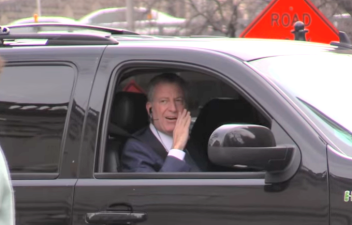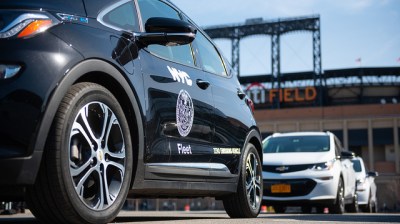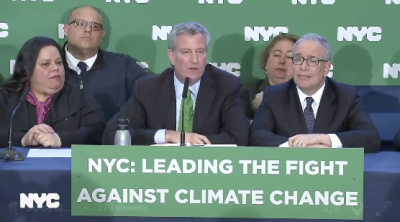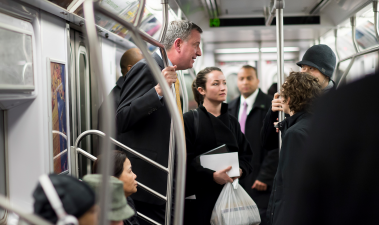No More Empty Gestures — Here’s How de Blasio Can Really Divest NYC From Fossil Fuels
Climate change is a serious threat. Selling city pension funds' stake in the fossil fuel industry to other investors is not a serious response.

Mayor de Blasio is at it again, making another empty gesture that mimics climate action without taking any real steps to decrease greenhouse gas emissions. This time, de Blasio teamed up with his London counterpart Sadiq Khan to grandstand in the Guardian, urging other cities to follow their example and divest public pension funds from the fossil fuel industry.
The threat of catastrophic climate change demands a serious policy response. But as long as the mayor perpetuates policies that let our car-based transportation system burn through gasoline like it’s 1960, New York will continue to pump money into the fossil fuel companies that are broiling the planet. Unless de Blasio and the world’s mayors actually set cities on a trajectory to consume less oil, it won’t make much difference if their pension funds sell their stakes in the fossil fuel business to other investors. It is not a serious response.
Real divestment from fossil fuels will require a clean break with the public policies that have propped up car ownership and driving at the expense of cleaner, more efficient modes of transportation. Here’s a look at what that would look like in the context of New York City transportation, starting with the factors that de Blasio can control most directly.
Shrink the city’s car fleet
Since de Blasio took office in 2014, the city’s car fleet has grown by 10 percent and city employees are driving 25 percent more miles, according to the New York Times. NYPD alone spent nearly $95 million on gas over the five most recent fiscal years.
A mayor who’s serious about divesting from fossil fuels would start by getting his own employees to drive less, which is a tough ask when the whole city knows you get driven 12 miles to the gym every day.
No more parking placards
NYC’s parking placard system provides a gigantic incentive for placard holders to drive everywhere. A 2006 study by Bruce Schaller found that city employees who work in Manhattan below 59th Street car commute at nearly double the rate of other workers, which Schaller attributed in large part to the free parking granted by placards.
Instead of reducing the number of city parking placards, de Blasio has increased the official placard supply by roughly 50 percent. That’s tens of thousands of city employees who have an extra incentive to drive to work and put money in the pockets of Big Oil, thanks to our mayor.
Eliminate parking minimums
Like access to a parking placard, access to a guaranteed parking space inside your home or workplace makes New Yorkers much more likely to drive. And since 1961, city zoning rules have required new buildings to include car parking. For 57 years, these parking requirements have induced driving trips and increased spending on gas, all while crowding out other uses of scarce New York City land for the sake of car storage.
A mayor who’s genuinely committed to preventing a climate change disaster would lead an all-out assault on parking minimums, but de Blasio has merely tinkered around the edges of the current system, lowering parking mandates for subsidized housing near transit.
Bus lanes and bike lanes, not ferries
New York City ferries will never generate the ridership that buses and bikes can generate on streets designed to prioritize transit and cycling — travel by boat involves too many transfers and doesn’t get people close enough to most destinations to move massive numbers. But you’d never know that from de Blasio’s budgets.
The de Blasio administration has spent hundreds of millions of dollars on a ferry system that moves as many people as a single moderately busy bus route. The one advantage ferries have is political: Because boat docks don’t take away space from gas guzzling cars (and keep that money flowing to the fossil fuel industry), they appeal to timid mayors in a way that bus lanes and bike lanes never will.
Get behind congestion pricing already
City Council Speaker Corey Johnson gets it. Reducing car traffic is such an imperative for the health and vitality of New York that Johnson wants to enact congestion pricing without waiting for approval from Albany.
In nearly five years as mayor, de Blasio has never even plainly said that he supports congestion pricing. Meanwhile, New York City traffic keeps getting worse and the oil merchants keep raking in more cash from city drivers.
Develop more near transit
Last but not least, the more New York City grows, the less pressure for development to extend outward into car-centric, greenhouse gas-belching sprawl. But in some of the most transit-accessible districts of the city, zoning prevents development beyond a few stories. Despite pushing for a few upzonings, de Blasio has not challenged the NIMBY power base in the affluent central neighborhoods where new development can increase the city’s supply of housing with minimal impact on working class households. And every person who opts for the suburbs because they couldn’t find or afford space in NYC is a gift to the fossil fuel industry.





